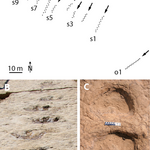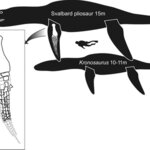Paleontology

Scientists have reported evidence of a large ornithopod dinosaur, as well as a herd of 11 sauropods, walking along a Mesozoic coastal mudflat in what is now the Republic of Yemen - the first dinosaur tracks on the Arabian Peninsula.
The finding also is an excellent example of dinosaur herding behavior, the researchers report. The site preserved footprints of 11 small and large sauropods — long-necked, herbivorous dinosaurs that lived in the Jurassic and Cretaceous periods — traveling together at the same speed.
“No dinosaur trackways had been found in this area previously. It’s really a…

Birds, unlike mammals, lack a tissue that is specialized to generate heat. A team of researchers at New York Medical College writes that the same lack of heat-generating tissue may have contributed to the extinction of ... dinosaurs.
Humans, like all mammals, have two kinds of adipose tissue, white fat and brown fat. White fat is used for storing energy-rich fuels, while brown fat generates heat. Hibernating bears have a lot of brown fat, as do human infants, who have much more than adults, relative to their body size. Infants’ brown fat protects them from hypothermia. Clinicians would like…

A 240 million year-old Ichthyosauria specimen went on display at Tromsø University Museum in northern Norway. The Botneheia ichthyosaur, presumably a new species, was the largest predator of its day.
A team from the University of Tromsø, the Norwegian Polar Institute, and the University of Tübingen discovered the exceptionally large specimen at Svalbard, Norway. The preparation and exhibition of the fossil was sponsored by the Norwegian oil company StatoilHydro.
What species is it?
The fossil from the Botneheia Formation at Sauriedalen, Svalbard belongs to the Ichthyosauria (meaning ”fish-…

After half a century of debate, a University of Alberta researcher has confirmed that dome-headed dinosaurs called pachycephalosaurs could collide with each other during courtship combat. Eric Snively, an Alberta Ingenuity fellow at the U of A, used computer software to smash the sheep-sized dinosaurs together in a virtual collision and results showed that their bony domes could emerge unscathed.
The computer simulations by Snively and his co-author Andrew Cox of Villanova University offer clues as to how the dinosaurs (between 80 and 65 million years old and native to Canada, the United…

Tiny prehistoric bones found on an Australian farm have been directly linked to a strange and secretive little animal that lives today in the southern rainforests of South America.
The mystery? They are separated by an ocean and millions of years.
The fossilised ankle and ear bones are those of Australia's earliest known marsupial, Djarthia, a primitive mouse-like creature that lived 55 million years ago. It is a kind of Australian Eve, possibly the mother of all the continent's unusual pouched mammals, such as kangaroos, koalas, possums and wombats.
But a new study has confirmed that…

A shape comparison of the most complete fossil femur (thigh bone) of one of the earliest known pre-humans, or hominins, with the femora of living apes, modern humans and other fossils, indicates the earliest form of bipedalism occurred at least six million years ago and persisted for at least four million years.
William Jungers, Ph.D., of Stony Brook University, and Brian Richmond, Ph.D., of George Washington University, say their finding indicates that the fossil belongs to very early human ancestors, and that upright walking is one of the first human characteristics to appear in our…

On September 27, 2004, the front part of a baby mammoth’s body was found in Olchan mine in the Oimyakon Region of Yakutia. Specialists of the Museum of Mammoth of the Institute of Applied Ecology of the North, Academy of Sciences of Sakha Republic (Yakutia), have been thoroughly studying the finding and they have published the first results.
The remains were only the head, part of the proboscis, the neck area and part of the breast of the baby mammoth’s body. The body was mostly cut off behind the withers and shoulder area. The skin on the head was torn on the forehead and cinciput, the skull…

A cool morning breeze keeps the mosquitoes down as we pack our kayaks and gear for today’s paddling journey. It is day four of our holiday, with two days driving up from Vancouver to Cache Creek, past the Eocene insect and plant site at McAbee, the well-bedded Permian limestone near Marble Canyon and onto Bowron Provincial Park, a geologic gem near the gold rush town of Barkerville.
The initial draw for me, given that collecting in a provincial park is forbidden and all collecting close at hand outside the park appears to amount to a handful of crushed crinoid bits and a few conodonts, was…

A pliosaur is a type of plesiosaur, a group of extinct reptiles that lived in the world's oceans 205-65 million years ago. Pliosaurs are characterized by tear-drop shaped bodies with two pairs of powerful flippers used to propel them through the water. They were top predators during their day, preying upon fish, squid-like animals and other marine reptiles. They averaged 16-20 feet in length with flippers 3-4 feet long.
One of the largest known pliosaurs, the Australian Kronosaurus, measures 33-36 feet long with 6-foot-long flippers. By comparison, the the 150-million-year-old Svalbard…

"Yeeeehaaaaaw" the call heard from a lucky fossil hunter working the outcrops on the west side of the lake... or just as likely the call of the wild as a kayaker hits a pocket of wind on freshwater and feels the power of nature surge under them - ahhh Harrison!
While it is just on the edge of what most consider a day trip, a good coffee and an early start are all you need to beat traffic and try your luck hunting for fossils in the the Cretaceous/Jurassic exposures that outcrop along Harrison Lake. For years we've collected ammonites, buchia&belemnites in the somewhat unyielding…